Welcome to CULINARIUM ALPINUM - Information about the media guide
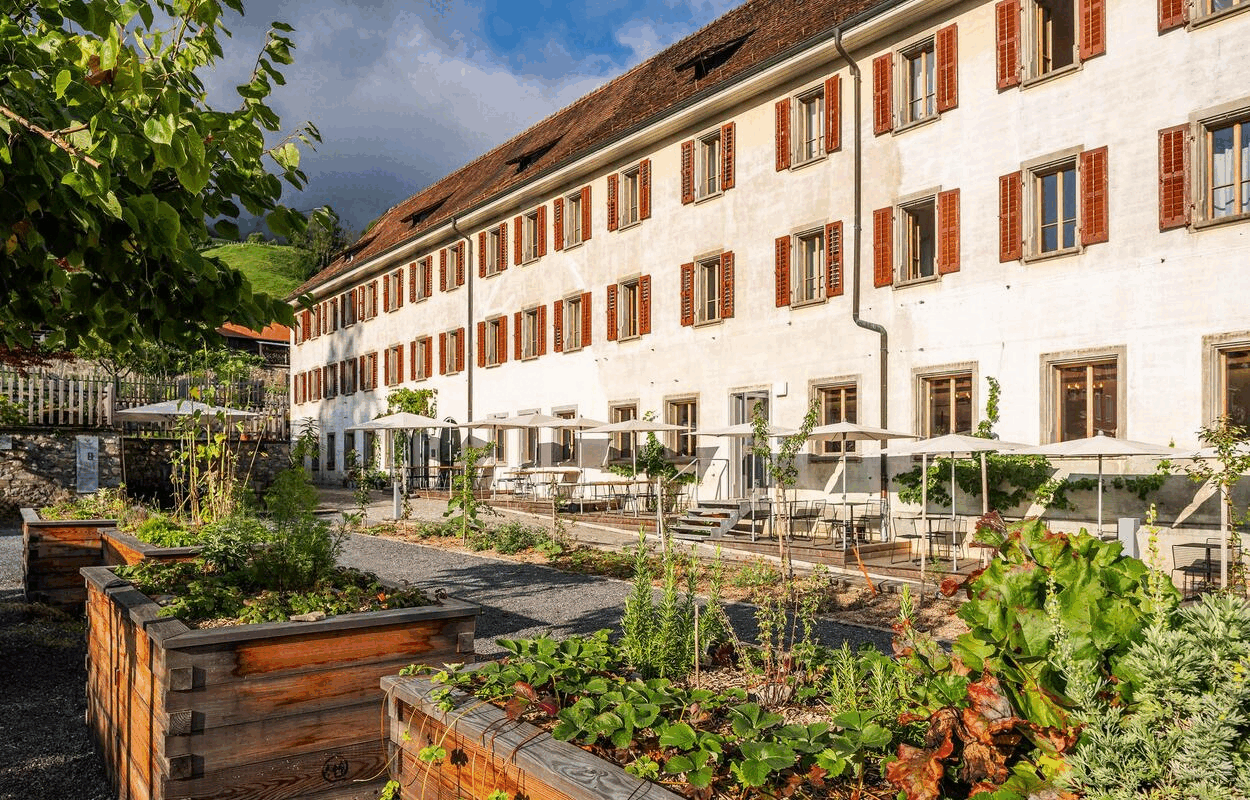
Welcome to CULINARIUM ALPINUM - Information about the media guide
Welcome to CULINARIUM ALPINUM - Information about the media guide
The Culinarium Alpinum – where history, enjoyment and the diversity of regional cuisine in the Alpine region come together. Andres Lietha, managing director of the foundation, welcomes you!
The building has an eventful past. It was built in 1584 as a Capuchin monastery and served as a place of prayer, education and community service for almost 400 years. Since 2020, the monastery has been shining in new splendour – as a centre for regional cuisine in the Alpine region. Here, the connection between tradition, innovation and sustainability is brought to life. Author Dominik Flammer has made the topic accessible to a wide audience in his book on the culinary heritage of the Alps and is the initiator of the Culinarium Alpinum.
During your tour of the edible landscape, you will have the opportunity to immerse yourself in the diversity of the plant world and follow reflections on current events. Incidentally, the edible landscape is designed as a snack garden. So help yourself when you discover sweet fruits and ripe berries!
This media guide was created to give our visitors easy access to the CULINARIUM ALPINUM. Please note that not all stations may be accessible during private or public events. We ask that you always be considerate of other guests during your tour and do not disrupt operations.
We are also happy to offer personalised tours to interested individuals. These tours provide more in-depth information on all elements of this media guide and can be combined with other offerings such as seminars, tastings and cooking classes.
Do you need help during the tour? Please speak to our staff or contact reception.
Do you have any feedback on this media guide? We look forward to hearing from you at keda@culinarium-alpinum.ch.
Now go to the front of the monastery building, to the entrance and in front of the door to the monastery shop. This is where the tour through the edible landscape begins.

The edible landscape
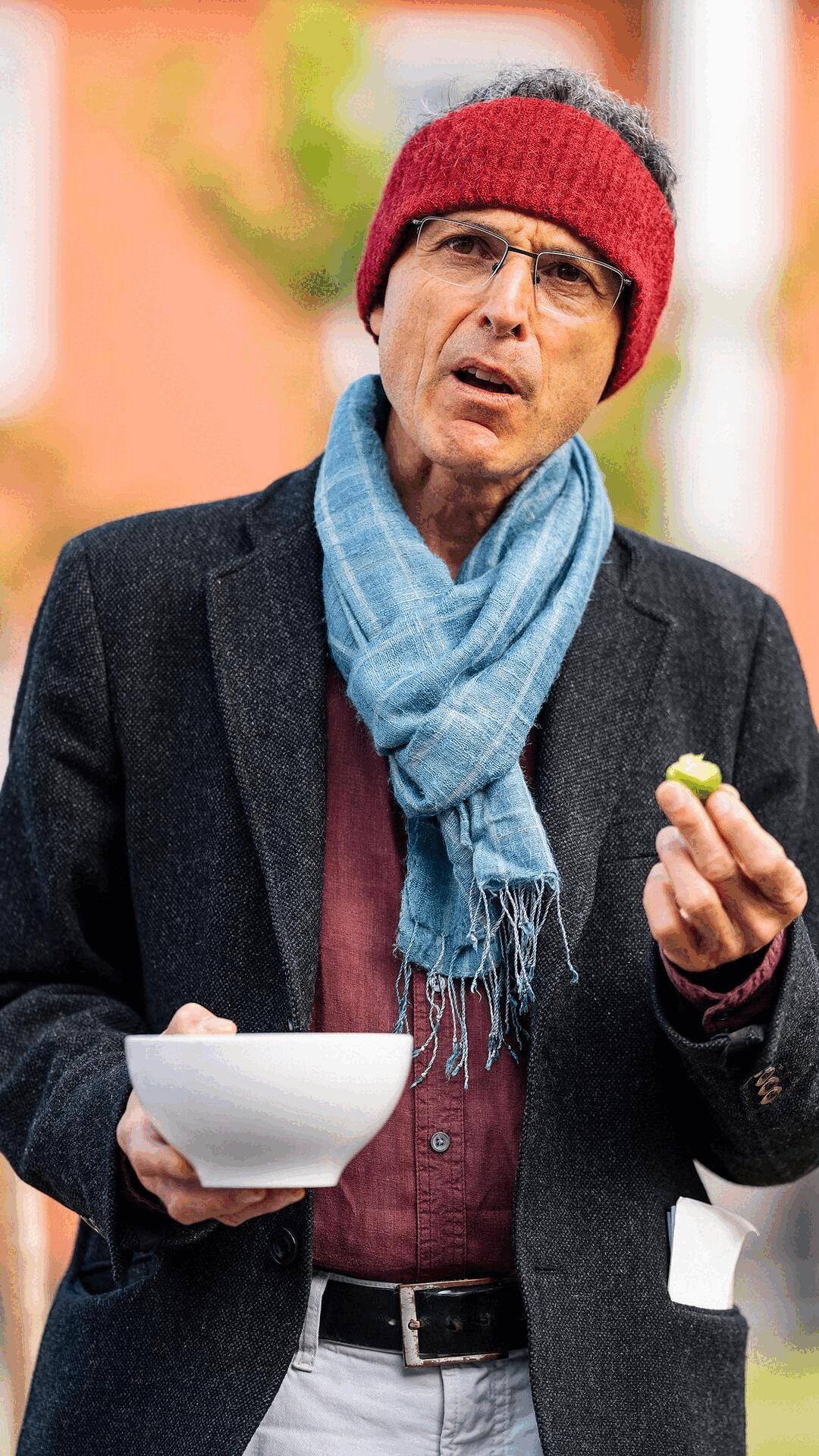
The edible landscape
The edible landscape
Sigi Tatschl, born in Zurich with Austrian roots, now lives in Kirchberg am Wagram – a place that has long since been transformed into an orchard thanks to his dedication. Even as a child, he associated berries with a deep sense of happiness and timelessness. This was triggered by a scene under an old pear tree at the edge of a pasture: wild strawberries grew there, sweet and fragrant. These early taste experiences had a lasting impact on him.
His passion for fruit developed over the years, driven by a curious, collecting nature. Tatschl wanted to know what was behind the varieties and collected rarities such as mulberries, Chinese dates and silver buffalo berries. His own garden soon became too small. From this abundance, a vision emerged: fruit should not only thrive in private spaces, but everywhere – in parks, school gardens, on green strips or in front of kindergartens. For him, no area is too small to be planted.
Today, Sigi Tatschl sees his work as a contribution to the design of ‘gardens of the future’. When Dominik Flammer invited him to the CULINARIUM ALPINUM in Stans, he knew immediately: this is where another berry paradise will be created. He believes that berries can do more than just taste good. They connect generations, invite people to harvest and enjoy together – and thus create a sense of community. A quality that is needed more than ever for a future worth living.
Start the tour at the entrance to the monastery walls. Along the wall, you will find the fruit hedge around the car park.

The fruit hedge
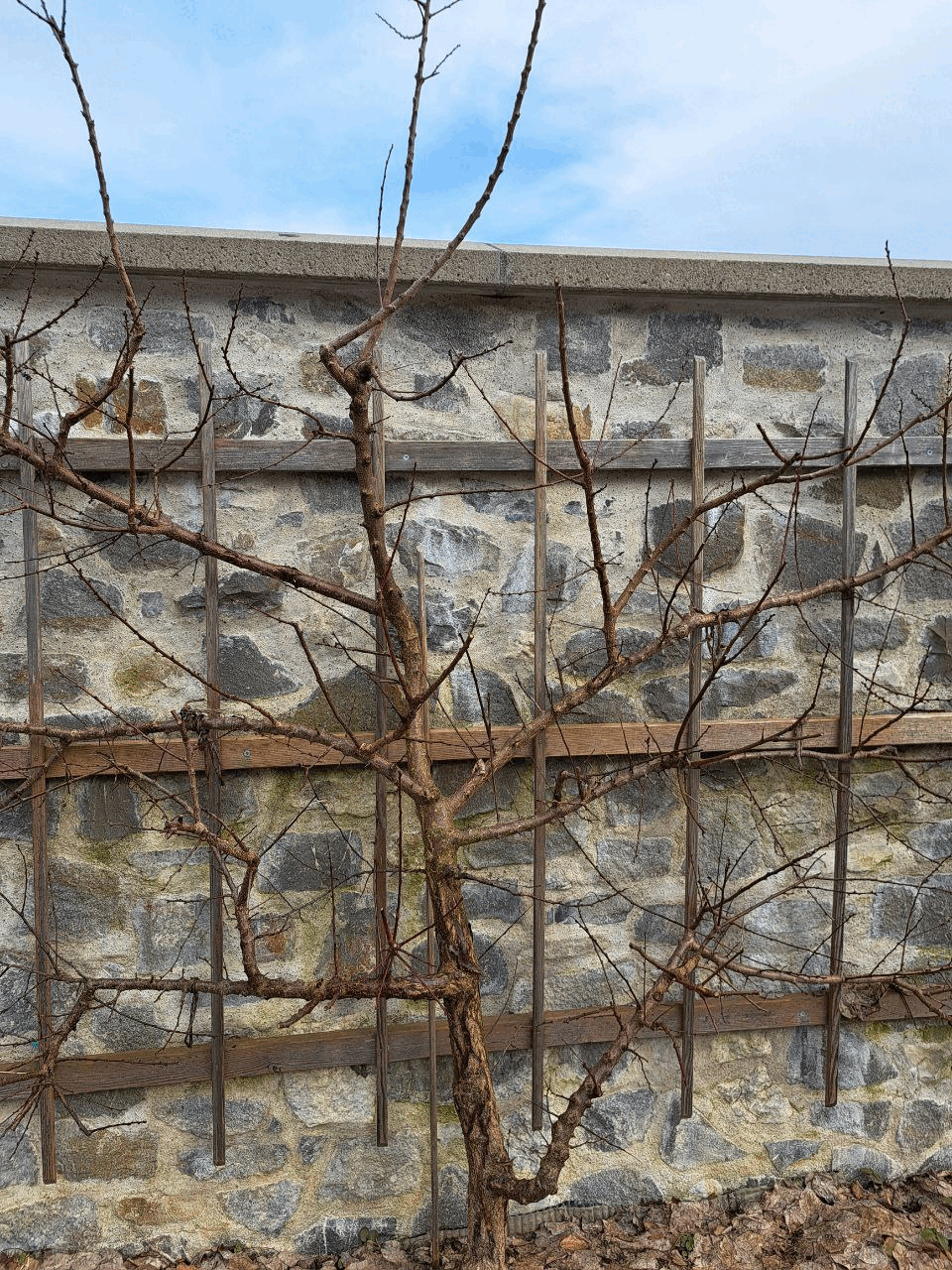
The fruit hedge
The fruit hedge
In this part of the edible landscape of the CULINARIUM ALPINUM, a landscape fruit hedge with a variety of trees and shrubs is being created, which is set to develop into a species-rich biotope in the coming years. Trees and shrubs are already growing between the path and the monastery wall – a living alternative to monotonous grey areas. Further down, between the car park and the road, the team has planted a variety of fruit hedges: currants, goldenrod bushes with edible nuts, shrub cherries and the red-fleshed Persian apple “Bakran” with its striking blossom make the strip a fertile learning and experience space. We pay special attention to our espalier trees along the monastery walls. Espalier pruning is visually striking, suitable for trees along walls, and ideal for giving the tree a long useful life.
There are numerous green spaces like this along roads, pavements and car parks in towns and villages. For Sigi Tatschl, the initiator of the hedges, they are perfect locations for natural fruit hedges. Instead of monotonous ornamental plants, edible and species-rich shrubs can grow here – along school fences or kindergartens, for example, where they not only provide privacy but also connect social and ecological spaces.
A particularly impressive example is the fruit hedge along the school fence: children snack on berries during break time, passers-by pick plums or mini kiwis on their way to work. Such encounters promote community spirit and raise awareness of where our food comes from.
CULINARIUM ALPINUM supports schools and communities in implementing such projects – from plant selection to planning. If you would like to plant a diverse fruit hedge yourself, you will find knowledge, advice and the right varieties for an edible, vibrant future here.
Go up the stairs on the left-hand side of the car park and follow the path to the roundabout. You will see the orchard on your left and right.

The orchard
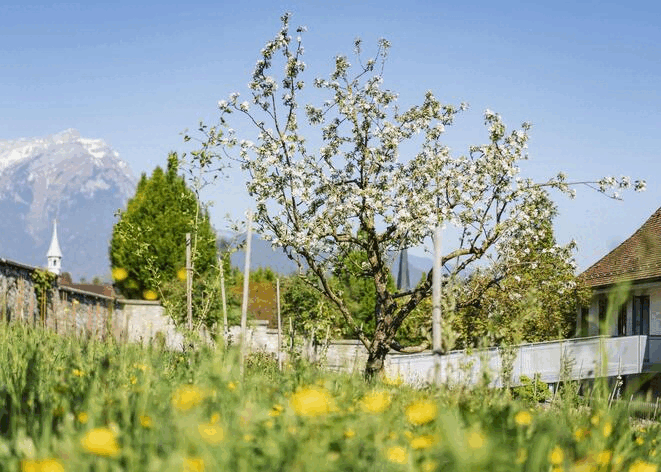
The orchard
The orchard
In the middle of the CULINARIUM ALPINUM garden lies a young orchard meadow. Orchard meadows originally emerged at the end of the 19th century as a result of the dual use of agricultural land: the hay was used to feed livestock, while the fruit was used for self-sufficiency. At that time, the trees were not planted in fixed rows, but seemingly ‘scattered’. If a tree died, it was simply replaced by the variety that was currently available – thus creating a colourful diversity.
Traditionally, large-crowned standard trees dominate the landscape: mighty cherry, apple and pear trees alongside slimmer varieties of damson, medlar and plum, often close to farms or in areas that are difficult to cultivate, such as stream banks or steep meadows. Today, these species-rich habitats have become rare – but their ecological importance remains high.
At CULINARIUM ALPINUM, the idea has been reimagined: small-crowned varieties have been selected that are also suitable for urban or village areas. The vision behind this is to turn Switzerland into an edible landscape – full of vibrant orchards in settlements, parks and in front of community centres.
Whether quince or sour cherry, peach or plum: fruit trees as local suppliers in public spaces not only offer delicious fruit, but also education, encounters and resilience. A persimmon tree, for example, yields up to 50 kg of fruit after a few years – a silent reserve for times of crisis. But often, even a small treat is enough: a fresh apple on the way home, a plum while waiting for the bus.
The CULINARIUM ALPINUM shows how it’s done – and invites communities, schools and committed individuals to take up this idea. Because there is a place for every ‘Safira’ or ‘Kolodovidnaja’ – two slender plum varieties. Even in your city.
Leave the Rondelle and walk along the monastery walls to the garden room. On the way, you will see the rarities on the upper left side.

Our rarities
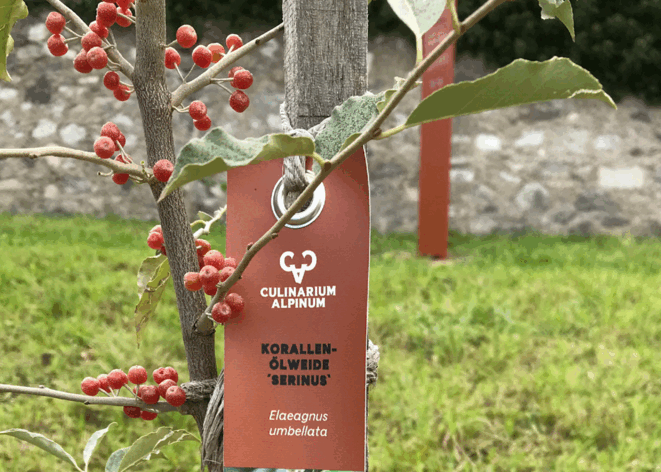
Our rarities
Our rarities
What actually makes a fruit variety rare? Often, it’s quite simple: anything that is unfamiliar seems rare. And in the case of fruit varieties, this applies to a large part of the natural diversity. In shops, you will find at most a handful of apple or pear varieties. Even in many nurseries, the selection remains limited. This gives children and young people a distorted picture of how colourful and diverse fruit can actually be – unless they visit the edible landscape of the CULINARIUM ALPINUM.
Here, you will encounter a world full of rare varieties: such as the Chinese date, which can be tasted in autumn. It looks like a date, but is not related to it – just like the kaki or susine, a Japanese plum variety. These so-called ‘new exotics’ contrast with traditional species such as apples and pears, which were introduced from Asia long ago but are increasingly reaching their limits in the current climate.
The Chinese date, for example, defies drought, likes poor soil, avoids late frosts and remains aromatic. Such robust varieties are a source of hope in times of climate change – and an inspiration for the future of domestic gardens.
There are also surprising discoveries in Switzerland – such as the dwarf serviceberry, a true alpine exotic. Anyone who finds it is helping in the treasure hunt for forgotten fruits. So what is your fruit rarity? Which variety should be preserved or rediscovered? We expressly welcome exchanges with curious gardeners, collectors and explorers.
Enter the garden room, take a look around and feel free to take your time to enjoy it. At the back is the insect hotel, where you can watch our smallest helpers at work. Then go to the right of the insect hotel and down the stairs into the realm of shadows.

Plants in the realm of shadows
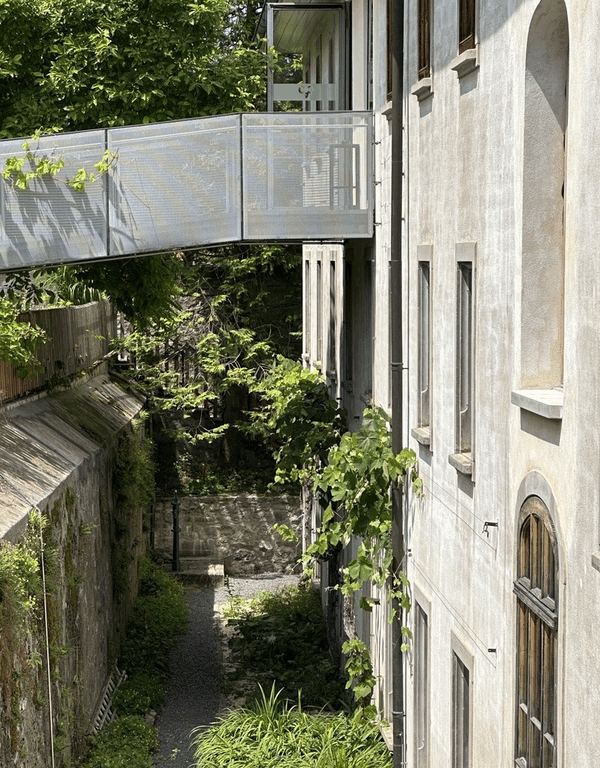
Plants in the realm of shadows
Plants in the realm of shadows
Now the path leads us into a shady area. It is cooler and quieter here than on the sunny meadow outside. The place almost feels like a forest room. Peaceful, sheltered and ideal for pausing for a moment. A Portuguese fig tree rises up between the trees, and delicate wood anemones grow at its feet.
This is an opportunity to return to the thoughts we had at the beginning of the tour: What can each and every one of us contribute to a good future – and what do berries have to do with it? Of course, berries alone cannot save the world. But they are a symbol of hope, a promise of abundance and joy. They inspire us to think in new ways.
In this moment of tranquillity, an unusual question arises: how would our environment experience the current changes if it could speak? How are the plants – the berry bushes, the apple trees – doing?
Perhaps they would say: „I need sun, but not too much – otherwise I’ll burn. I need water, which is becoming scarce. And without bumblebees, beetles and butterflies, I will no longer bear fruit.“ A powerful image. Anyone who listens will realise that plants need our care.
The answer to this silent plea could be: ensure vibrant diversity. Plant shrubs, herbs and grasses in good soil, plant large trees in between, create spaces where things buzz and flutter. Then we humans will thrive too.
Edible landscapes – colourful, diverse and vibrant – are a promise of the future for towns and villages. Those who care for them are investing in a world worth living in.
Then return to the garden room, walk to the front end of the garden room, turn right and go down the stairs one level. Follow the path to the herb bed – the newest area in the edible landscape.

Herb bed and flower bed
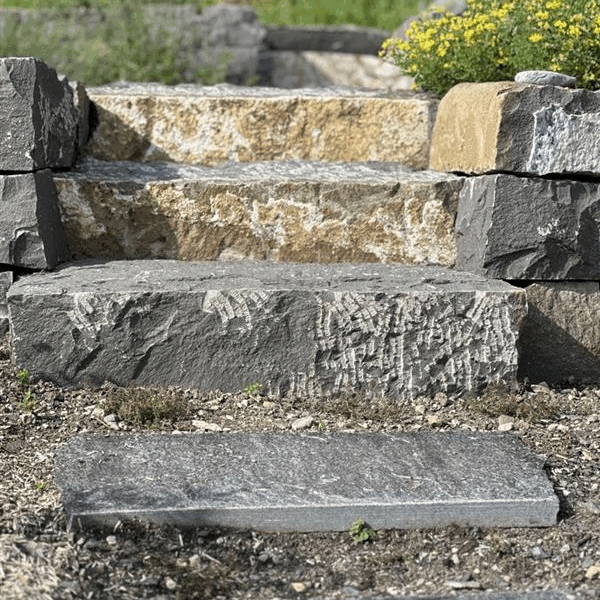
Herb bed and flower bed
Herb bed and flower bed
The herb bed is the latest addition to the edible landscape and was created in spring 2025. A variety of culinary herbs and selected edible Alpine plants grow in the carefully planted beds. They invite you to smell, taste and discover. Here, local flavours meet Alpine spices.
Special attention has been paid to the dry stone wall, which was built in collaboration with an expert. This ancient construction method, deeply rooted in the Alpine region, does not require mortar or concrete. The stones were brought in large blocks from a nearby quarry in Obwalden and split on site. Each stone was then artfully prepared and stacked to create a stable, breathable structure. The wall not only provides support, but also creates sheltered niches and warm spots – ideal conditions for heat-loving herbs such as thyme, hyssop and mountain savory. At the same time, it creates a species-rich habitat for lizards, wild bees and many other small garden dwellers. It is a place that shows how traditional techniques and modern diversity can come together to form a living whole.
Then walk down the two flights of steps to the front of the car park. Here you will find the flower beds. Finish the ‘NaTour’ tour with a coffee in the restaurant or stock up on delicacies from the Alpine region in the monastery shop.
Tip: If you are interested in a tour of the monastery, ask at the restaurant or reception for directions to the ‘KulTour’ tour.
See you next time!

